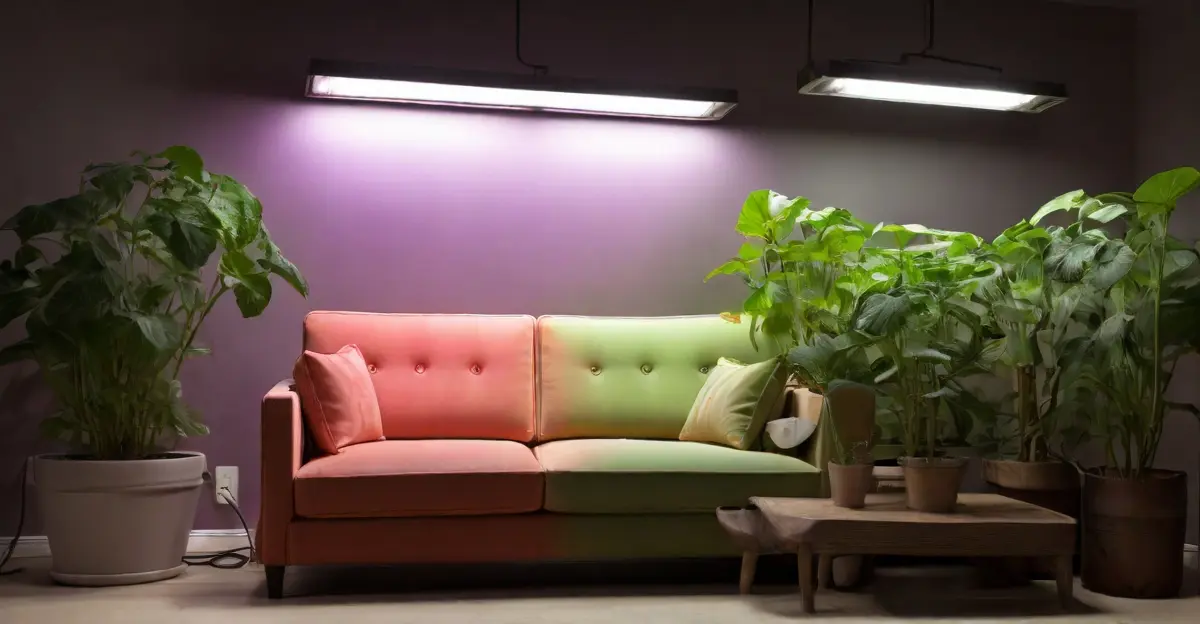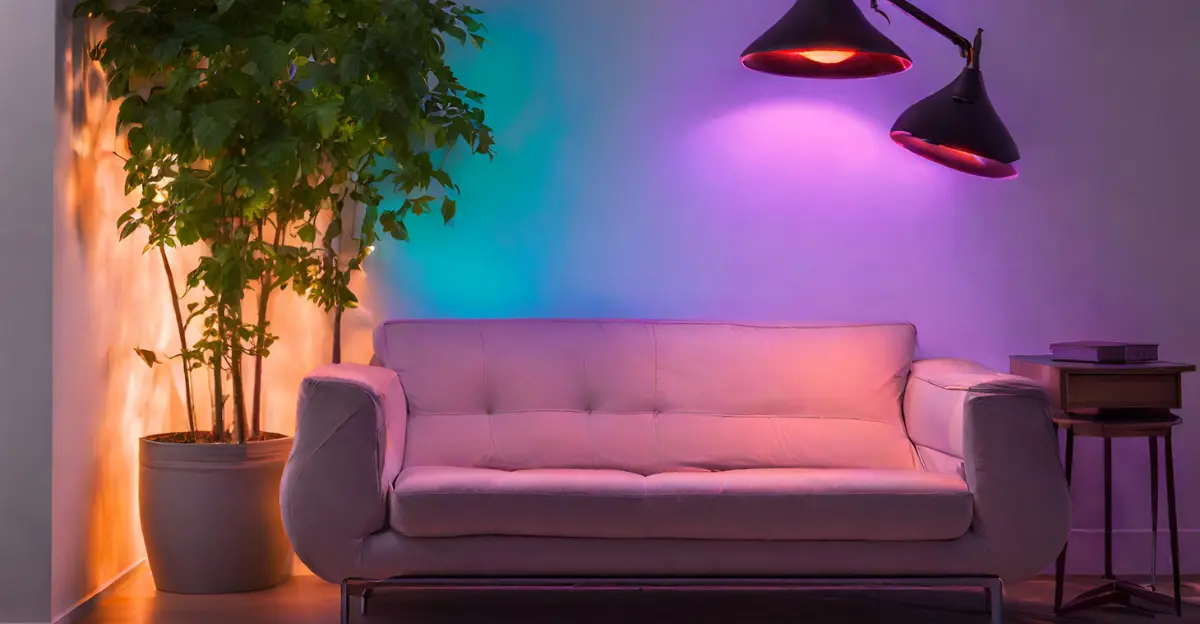Will Grow Lights Fade Furniture? Save Your Sofa Like This

Let’s rip the Band-Aid off here—yes, those powerful little grow lights you’ve got illuminating your indoor plant paradise can very well turn your prized living room sofa into a faded, discolored mess.
Not the chic look you were going for, right?
But don’t ditch your green thumb dreams just yet!
While intense grow lighting is crucial for nurturing lush foliage when gardening indoors (especially in tight urban spaces), there are smart ways to prevent your furniture from becoming a tragic casualty.
The harsh reality is that the high-intensity radiation from HID, fluorescent, and even LED grow bulbs can degrade fabric dyes and damage certain materials over time.
Fear not, though—this post will equip you with the knowledge to tame those photon blasters and keep your decor looking fresh.
From understanding fading factors to easy safeguarding solutions, you’ll learn to harmoniously grow your plants and preserve your precious sofa.
Do Grow Light Actually Fade Furniture? The Reality
We get it—you’re an indoor gardening pro, carefully nurturing your precious plants under the radiant glow of specialized grow lights.
But here’s a harsh truth you might not want to hear: those same lights could be slowly turning your beloved furniture into a faded, discolored mess.
Before you panic and start unplugging everything, let’s break it down.
Furniture fading occurs due to prolonged exposure to light radiation and heat buildup.
The main culprit?
Ultraviolet (UV) rays, which are present in sunlight, can break down the chemical bonds in dyes and pigments, causing bleaching and discoloration.
But here’s the kicker—visible light, especially those pesky blue wavelengths, can also contribute to fading over time.
Now, the type of grow light you’re using plays a big role in the fading risk.
High-Intensity Discharge (HID) lights, like metal halide and high-pressure sodium, emit significant amounts of UV and heat, making them the worst offenders.
Fluorescent grow lights are a bit gentler, but still pack a UV punch (especially UVA).
LED grow lights emit negligible levels of UV and produce minimal heat, making them the safest option.
With that said, let’s discuss the major factors that affect your furniture in a not-so-great way.
Factors Affecting Furniture Fading

When it comes to grow lights slowly morphing your stylish living room into a half-baked, discolored mess, three key ingredients fuel the fading frenzy:
1. Light Intensity
The brighter and more powerful the light source, the faster those dye molecules get their butts kicked into oblivion.
UV radiation is an especially sinister offender here—one study found it contributes to 40% more rapid fading compared to visible light wavelengths.
And let’s not kid ourselves; grow lights like HIDs or old-school fluorescent packs more UV punch than your typical household LED bulb.
2. Duration of Exposure
Imagine two identical couches—one chilling in a shady, light-free den and the other basking under grow lights for 6 hours daily.
You already know which one’s going to be rocking that vintage, sun-bleached Look by next spring.
Light damage builds up over time, so limiting those exposure windows is crucial for keeping your decor vibrant.
Active grow tents in constant use are way riskier than setups that only run during daylight hours.
RELATED: Grow Light Duration Calculator
3. Furniture Materials
Of course, not all materials are equally susceptible to this onslaught of photonic fury. Some fabrics, woods, and dyes just have a lower tolerance for abuse.
Cotton, linen, wool?
Those natural fibers practically wave a white flag at the first sign of UV rays. Synthetic upholstery like polyester and nylon tend to hold their own better (source).
Light color palettes also fade faster than darker, richer tones. So that creamy white sofa’s gonna start kicking up dust way before your chocolate brown leather armchair shows any age.
As for wood furniture, species like cherry and walnut will eventually succumb to unsightly UV graying, while maple and birch are more stubborn against discoloration (source).
Preventing Furniture Fading

Alright, you now know the harsh reality—grow lights are a serious risk to your furnishings if not handled with care.
But don’t panic!
With some smart strategies, you can keep those nagging rays at bay and protect your decor investments.
Let’s dive into some essential tactics:
A. Distance from Furniture
Distance is your best friend here.
The further your grow lights are positioned from any furniture or surfaces you care about, the less intense that light exposure becomes.
A general guideline is to keep grow lights at least 3–5 feet away from anything, you don’t want to get a premature suntan.
SUGGESTION: Consult the manufacturer’s guidelines for your specific grow lights to determine the recommended minimum distance from furniture and other surfaces.
Of course, you’ll want to balance this spacing with ensuring adequate light coverage for your plants.
But a little creative setup arrangement can go a long way. Use reflectors or shades to efficiently direct that light right where you need it—onto your green buddies.
FURTHER READING: How Far Should a Grow Light Be From Plants for Best Growth
B. Protective Covers
If distance just isn’t an option in your cramped space, don’t sweat it.
Busting out some light-blocking covers or curtains can physically shield your furniture from those pesky photons.
Opt for tightly woven, UV-resistant fabrics like canvas or solution-dyed acrylics like Sunbrella.
These bad boys will deflect both visible light and aggressive UV rays. Just be sure to allow some airflow to prevent accidentally cooking your plants.
C. Plant Stands
Elevating your plants on shelves or stands creates an extra barrier between your grow lights and floor-level furniture like sofas and coffee tables.
It’s a simple yet genius hack to increase that all-important distance.
Plus, having plants up off the ground provides better air circulation—something they absolutely crave when bathed in those bright artificial rays.
D. Ventilation and Temperature Control
Speaking of air circulation, proper ventilation is a must when operating grow lights, especially the more intense HID varieties.
Not only does it provide fresh air for your plants, but it helps remove excess heat buildup that accelerates fabric fading.
While you’re improving airflow with fans or vents, keep temps in your grow space at that sweet spot for plant growth.
Excessive heat only compounds the damaging effects of light on nearby materials.
E. Controlling Working Hours
At the end of the day, the less overall time your furniture spends basking beneath those grow lights, the lower its risk of fading.
Easy as that!
Most plants only require about 12–18 hours of daily illumination.
So invest in an automatic timer and schedule those lights to only burn during set periods when you’ll be around to enjoy the show anyway.
You’ll not only preserve your decor’s youthful radiance but save a few bucks on that electric bill too. It’s a win-win!
Bottom line—distance, blockades, ventilation management, and moderation are your allies against premature furniture aging. Be proactive and show your grow lights who’s boss!
Key Takeaways and Summary
Let’s quickly recap the main factors fueling that dreaded furniture fading from grow lights:
But fear not!
You’ve now got an arsenal of easy tips to keep your furniture looking fresh while rocking your green thumb:
At the end of the day, it’s all about striking that perfect balance between stylish decor and flourishing houseplants.
FURTHER READING: How Long Should a Grow Light Be On (For Best Plant Growth)
Meet your guide
Dhruvir Zala